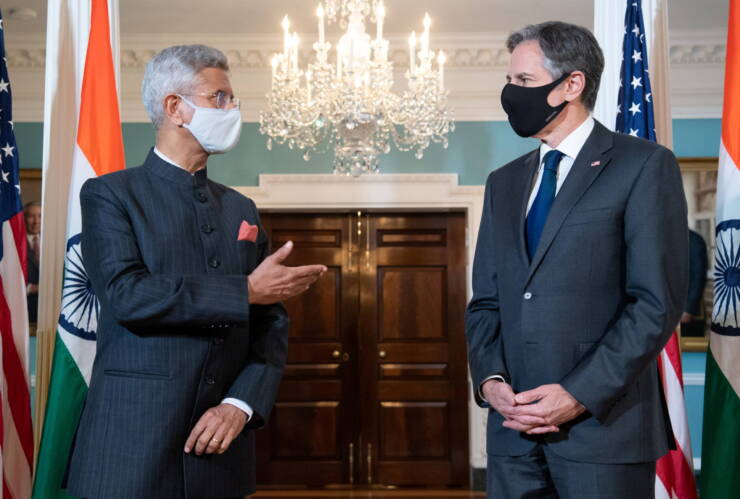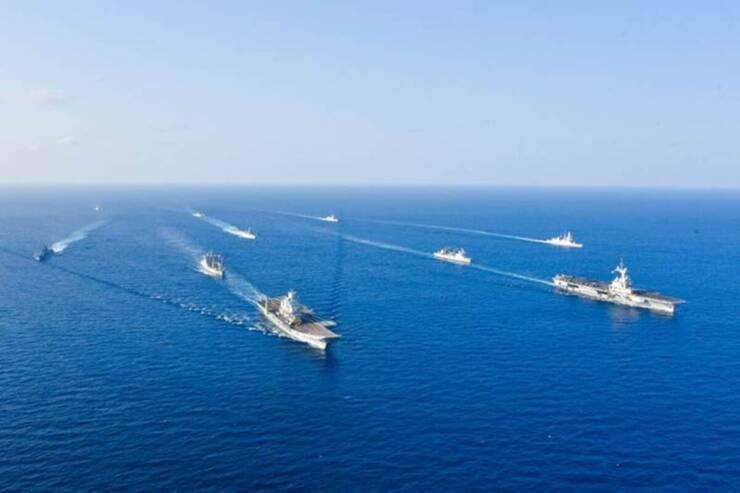
There has been a debate in the media of late about the adequacy of professional military education (PME) and military jointness and joint operational training. Jointness in our military is coming up gradually for reaching the required levels of joint operational training. Addressing issues like PME and joint operational training in isolation is useless because the real test of any military is in war. It is therefore essential to first determine the contours of future war and war game possible scenarios for deriving lessons to include what PME, structural cohesion and joint operational training we need.
China is our main adversary and it has been waging a continuous war with us for the past decades, its latest actions being the biological attack in 2019 and aggression in Ladakh during 2020. The Chinese military is reorganised and technologically better. Therefore, it would be prudent for us to war game the ‘worst case’ scenario with China and examine how we can ensure victory. This would give us a roadmap of what capacities we need to build individually and in concert with strategic partners, as well as chalking out a timetable to achieve these. However, for making headway, the hierarchical understanding of our policy makers must change from war meaning only conventional war and national security meaning only military security.
Visiting the United States Indo-Pacific Command (INDOPACOM) on April 30, 2021, US Secretary of State Antony Blinken said, “We can’t predict the future. What we need is the right mix of technology, operational concepts and capabilities all woven together and networked in a way that is so credible, flexible and so formidable that it will give any adversary pause. We need to create advantages for us and dilemmas for them.”
Blinken said deterrence must become ‘Integrated Deterrence’ to include best weapons systems, latest technologies making adversaries think twice (with tools like artificial intelligence and quantum computing), new concepts of operation, eliminating inter-service stovepipes and their capabilities, coordinated operations on land, air, sea, space and cyberspace, all of which means working together in ways that was not done before.
China has been constantly striving for the above strategy and perhaps that is why Blinken referred to China as the “pacing challenge” of the American military and a “near-peer”. China’s biological bombing of the world, laser attacks on US pilots, microwave attack on US diplomats and the recent cyber-attack on America’s Colonial Pipeline are examples of what future conflicts could include.
The concept of ‘Unrestricted Warfare’ defined by two Chinese Colonels advocates that “warfare constitutes an independent sphere of action in which ethical standards are not applicable”. It expands the concept of warfare to both military and non-military means; increased violence capacity perpetuated by technological advances in other dimensions like politics, economics, and information networks. The various means described include nuclear, biochemical, ecological, space, electronic, guerilla, terrorism, networks, psychological, smuggling, drugs and virtual.

Developing a bio-weapon and using it deliberately proves ethics don’t matter to China. Covert employment of biological, neurological and chemical warfare by China should be expected. In the past decades, western strategists have been saying in closed discussions that China could use tactical nuclear weapons against India for territorial gains. This should not be ruled out if China calculates that we lack the political will to respond similarly for fear of counter-counter strike on our population centres.
China’s psychological warfare is a constant factor that needs no elaboration. Cyber-attacks from China are daily occurrences, including for targeting our satellites, fighter aircraft and drones with occasional hits on critical infrastructure as warnings – Delhi’s T3 airport, Mumbai’s electricity grid and Covid vaccine development facilities being some examples.
Unrestricted Warfare makes repeated references to political roles played by non-state actors, ranging from credit rating agencies to narco-mafias, and its emphasis on the “civilianization of war” thesis; in the same way that modern technology is changing weapons and the battlefield, blurring who the war participants are. A strategy of ‘Deep Coalition’ is followed, which may consist of multiple nation-states, civil society organizations, narco-mafias, private corporations whose interests are at stake, individual speculator(s), and other components. “Deep Coalition” involves players at many levels of the system operating all the time in continuous flow.
For anyone who feels the strategy of ‘deep coalition’ is theoretical, think twice and witness how it is being used against India. Both China and Pakistan have developed proactive sub-conventional capabilities that they are using against us in conjunction with indigenous forces inimical to India. China is also using terrorist outfits and narco-mafias of Myanmar to wage a silent war on India. It would be wrong to not acknowledge that India’s narco-mafia with political patronage too is assisting China and Pakistan.
China has advanced cyber warfare capabilities, which along with its ‘Assassins Mace’ weaponry will be selectively passed on to Pakistan or used by the PLA from Pakistani territory or POK. The result of China’s political warfare and strategy of “deep coalition” is that despite the Chinese aggression in Ladakh and refusal to step back from Depsang, Gogra and Hot Springs, it has not affected India-China bilateral trade; China enjoys the same trade advantage and Chinese banks in India continue to enjoy roaring business. After all the noise of banning some Chinese apps, many like Tik Tok are back with a bang.
It may be seen from the above that war is no longer an ‘exclusive military’ affair. Conventional forces and diplomacy is no match to hybrid warfare in which we are engaged continuously. War is dirty, without any rules, especially in confronting rogue China. CBRN (Chemical, Biological, Radiological and Nuclear) threats from state and non-state actors are likely to increase. Exercising strategic restraint in hybrid war is detrimental to our national interest; China takes it as a sign of cowardice. Success in conflict, especially against adaptive and agile adversaries, requires a shift from only kinetic to include influence activity.
Technology will remain important, but the populace is likely to provide an asymmetric edge if invested in and empowered – building comprehensive national power (CNP). After the 26/11 Mumbai terrorist attacks in 2008, Indonesia conducted a national level three-day counter-terrorism exercise that included the military, all security forces and the national security set-up, acknowledging that current threats are less predictable than traditional state-centric ones and come from more diverse sources.
Acknowledging that war is no more an exclusive military affair, we need to run a war game at national level for combating future wars to derive lessons on how the national effort can be harnessed. But this is unlikely considering that 74 years after independence we still do not have a comprehensive national security strategy and a government-appointed task force headed by the NSA in 2019 has still not defined one.
The military could run a war game in the setting of ‘worst case’ scenario – short of full-scale war: open with enemy’s non-contact operations like electronic and cyber-attacks to paralyse communications, target critical infrastructure and environmental attacks to warn politico-military authorities; psychological operations and provocative air and naval activity to intimidate adversary; long range weapons to disrupt mobilisation; selective actions along dual front with third front (sub-conventional) fully activated, while India combats viruses; activation of air, sea, space and cyberspace; mass employment of AI-enabled weaponry, stealth-hypersonic systems, solid-state lasers, and; use of tactical nukes, bio-weapons and microwaves in border areas only at selective spots.
The above scenario may look utopian but if China is eventually to fight the US, India is its best bet to try out its military capacities for conveying a message to the US and the rest of the world. A re-run of the war game to the policy makers is warranted, even if they dismiss it outright. Recall that the Army’s Central Command ran a war game in mid-1962 for the then Defence Minister VK Krishna Menon bringing out how the Chinese invasion was likely to take place. Menon brushed it off as rubbish and we know the outcome. Similarly, the present political leadership must be apprised about what can happen and that wars cannot be won through media manipulation.
The view that technology and AI will rule conflicts is misplaced. Humans who quickly exploit the battlefield have invariably overcome technological disadvantages to deliver victory. AI and technology no doubt are important in future conflicts but the best bet for victory is developing tactical, operational, and strategic innovators who will leverage battle-space conditions to achieve victory, regardless of the technical balance. The US-Vietnam war is a perfect example of this. China understood this recently at Galwan and is working on genetically developed super-soldiers (sic).

The war game will indicate shortcomings and changes required including for PME and joint operational capabilities. Considering our capability gap vis-à-vis China, we should develop the following: credible cyberspace, space and information warfare capabilities; pro-active sub-conventional capabilities against China-Pakistan in conjunction with like-minded nations; ‘deep coalitions’ to weaken China-Pak nexus and assist in winning the hybrid war, counter to China’s ‘Assassin Mace’ weapons; networked forces with precision strike and stand-off capabilities; combine Aerospace Command and Cyber Command into Strategic Support Command while Theatre Commands are being planned; nodes of excellence for China and regions of strategic interest, and; define a comprehensive national security strategy and streamline the national planning process. We cannot win wars with the rules of Mahabharata – see the examples of China, the US and Russia aside from the World Wars. We must develop covert counters to CBRN threats for use when warranted.
Finally, we need to maximize influence in our neighbourhood and leverage strategic partnerships to enhance our capacity to fight future wars. Quad nations exercising with the French Navy was a good beginning. The US, Japan and France participated in ARC-21 exercise (May 11-18) in Japan. We should be looking at Tri-Service joint exercises with Quad members and France in India; naval components exercising in the Indian Ocean and balance in north and northeast India. Developing interoperability and joint operational capacities with strategic partners should be a focus area.
-The author is a veteran of Indian Army. The views expressed are personal and do not necessarily reflect the views of Raksha Anirveda








